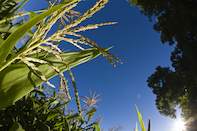Various types of rot rotting diseases in maize exist that may affect the lower stem or spaces between maize kernels. Rot is usually caused by moist conditions and may result in yield losses, a reduction in maize quality and produce toxins that are harmful to humans and animals.

Ear Rot in Maize
Diplodia, Fusarium and Gibberella are the major maize ear rot diseases in South Africa. Each of these diseases are caused by different fungi or a fungi complex, which may also affect other parts of the plant.
Diplodia ear rot usually occurs during early ear development. The infection starts at the ear base, causing the yellowing and drying of husk leaves, and then ramifies upwards until the whole ear is overgrown with mycelial growth. Black spore producing bodies are evident in the kernel and cob tissue.
Late season infections may result in “skelm Dipoldia”, which may result in a slight discolouration of embryos.
Fusarium ear rot symptoms vary depending on the maize cultivar, environmental factors and disease severity, with the disease being most severe under hot, dry weather conditions after flowering.
According to Pannar, the disease results in whitish fungal growth that is matted between the kernels and between the ear and the husks. Individual or groups of pink or whitish infected kernels may be scattered randomly and under severe conditions cover the entire ear. Fungal growth is also frequently found on the tip of the ear as a result of stalk borer damage.
As with Diplodia ear rot, the disease also starts at the ear base progressing toward the tip and there are black fungal fruiting bodies embedded in the cob tissue and kernel base.
Gibberella ear rot, also known as red ear rot or Graminearum ear rot, causes a dark red discolouration of the maize ear, starting at the tip of the ear, with superficial black specks developing on the husks and ear shanks. The entire ear may be rotted away under extreme conditions.
Stalk Rot in Maize
The same fungi and fungi complexes responsible for different root rot diseases, may also be responsible for different stalk rots. The part of the plant being affected is dependent on various environmental factors, such as climatic conditions and the growth phase.
As indicated by the name, stalk rot affects the stalk of the maize plant. This has a negative impact on nutrient uptake and also causes lodging – the term used for stems bending over making them difficult to harvest – and poor grain fill.
Grain SA identifies Diplodia, Gibberella and Charcoal as the most important stalk rots affecting maize in South Africa.
Diplodia stalk rot is most common in seasons with early rains and during persistent droughts. Infection becomes visible a few weeks after grain fill, resulting in the wilting of leaves and the lower internodes becoming brown and spongy. Small black fruiting fungi bodies appear near the nodes of the rind, with the rind becoming totally overgrown by white mycelia growth over time.
The stalk pitch also discolours and disintegrates, predisposing the plant to lodging.
The symptoms of Gibberella and Charcoal stalk rot are similar to that of Diplodia stem rot, except that Gibberella causes a pink or red discolouration of the stalk, while Charcoal stalk stalk rot causes the stem to turn a greyish black.
Charcoal rot usually occurs in warm dry areas and is most prevalent during drought years.